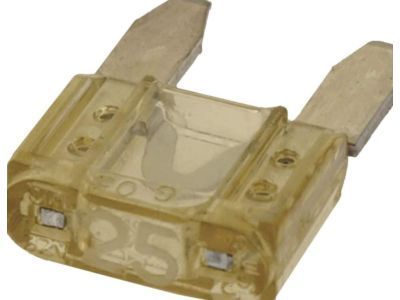
My Garage
My Account
Cart
Genuine Chevrolet Astro Fuse
Circuit Fuse- Select Vehicle by Model
- Select Vehicle by VIN
Select Vehicle by Model
orMake
Model
Year
Select Vehicle by VIN
For the most accurate results, select vehicle by your VIN (Vehicle Identification Number).
1 Fuse found
Chevrolet Astro Fuse,Mini 25 A
Part Number: 88909756$0.16 MSRP: $0.30You Save: $0.14 (47%)Ships in 1-2 Business Days
Chevrolet Astro Fuse
Each OEM Chevrolet Astro Fuse we offer is competitively priced and comes with the assurance of the manufacturer's warranty for the part. Furthermore, we guarantee the speedy delivery of your orders right to your doorstep. Our hassle-free return policy is also in place for your peace of mind.
Chevrolet Astro Fuse Parts Questions & Experts Answers
- Q: How are the electrical circuits safeguarded, and what should be considered when checking and replacing fuses on Chevrolet Astro?A:Protection of the electrical circuits of the vehicle is with fuses, circuit breakers and fusible links; the fuse block tray is located below to the dashboard on the driver side, more precisely to the left of the steering column. With the models produced since 1996 an Underhood Electrical Center is installed inside the engine compartment at the side of the driver and contain information on the fuses and relays on the lid. What is more, every fuse is intended to protect a definite circuit, and to know which circuit is protected by which fuse one has to look at the fuse panel. These models incorporate minisized fuses that may be removed and re-fixed easily with fingertips; in case of electrical failure, instead of running a diagnostic test one should check the fuse. The easiest way to test the fuses is to check the continuity of the electrical current by using the test light; if it lights at one terminal end but not at the other end, then the fuse is blown and this can also be checked by the naked eye. In case some fuse is blown, it should be replaced with the fuse of the same rating because fuse of different rating may be physically inserted but should not be used as the requirements for protection depend on the circuit. The amperage value is printed or cast into the fuse body, and it is warned against bridging the fuses with metal or foil as one might perilously damage the fuse this way. If a replacement fuse blows out as soon as it is in place, it must not be replaced again until the probable case of short circuit through faulty wiring is isolated and corrected.



